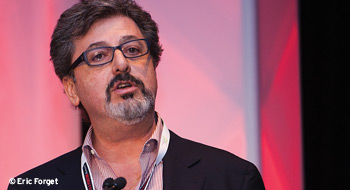
“I’m going to irritate a lot of people today,” began Dee Edington, keynote speaker on health management as a serious business strategy, at the Benefits Canada 2012 Benefits & Pension Summit. Drawing on his experience as director of the University of Michigan Health Management Research Center, Edington had a lot to say about what doesn’t work—interventions focused on behavioural change, for one.
“These are tactical approaches and should be way down the list of priorities. If people don’t know why they’re being asked to make these changes, the programs won’t work.” Despite all manner of lifestyle modification initiatives launched over the past few generations, he said, “there’s no evidence that we have less diabetes or more physical activity than in the 1950s.”
What does work? In Edington’s view, workplace health needs to follow the lead of workplace safety and quality initiatives, which have become enmeshed in corporate culture to the point that nobody questions their necessity. And rather than concentrating resources on people in poor health, he said corporations should focus on their healthiest employees and reward them accordingly. In other words, “help the workplace stay healthy, rather than waiting for defects and then treating [them].”
According to Edington, about 60% of employees are at low risk of major diseases. “What do corporations do for these low-risk people?” he asked. “In most cases, it’s zero. But these people are your champions. Typically, champions are rewarded in business. Why not reward them for health and wellness? These energetic people can lead a change in corporate culture.” For example, he continued, “we might give the nonsmokers a cash bonus and let the smokers figure things out on their own.”
In a nutshell, Edington’s vision is, “Integrate health into the corporate culture so it’s expected and assumed.”
Scalable wellness solutions
Jennifer Allan, vice-president of HR programs and corporate communications with The Economical Insurance Group (Economical)—a Canadian property and casualty insurance company—described how the company reintroduced wellness programming in 2008, after a hiatus.
The program aimed to build awareness of individual health; enhance employee engagement; reward employees for a broader range of wellness behaviours; enhance organizational health; develop a wellness program designed to evolve over time; and reduce group benefits costs and absenteeism within three to five years.
The first offering was individual screening sessions, where registered nurses took six health metrics (e.g., blood glucose, cholesterol and body fat levels), Allan explained. “Our employees got to see how close or how far they were from ideal ranges. In some cases, the feedback was life-changing.” And “the aggregate data gave us a snapshot of our organization’s health and made it possible to set goals.”
The program also includes wellness assessments through Economical’s benefits carrier, as well as team-based wellness challenges supported by online portals. Just over three years into the initiative, “we’re at the point where we’re seeing some impact on cost,” Allan affirmed.
For his part, Aldo Cundari, CEO of Cundari Group (a Toronto- and Montreal-based advertising company), described how he created a health-conscious corporate culture by putting staff, rather than management, in charge of wellness.
Cundari allocated a health budget to the Brand Squad—a group of employee volunteers tasked with building and promoting the Cundari culture internally.
One of the squad’s novel ideas was a bicycle clinic in the spring and fall, giving employees and clients a convenient opportunity to get their bikes serviced.
“It was a way to extend the health culture beyond the office,” Cundari explained.
The Brand Squad also launched soccer and hockey teams, a first for the organization. “I think one of the reasons my company is such a happy place is that I’ve let my staff choose what they want to do, rather than tell them what to do.”

 Challenges and changes for DC plan members
Challenges and changes for DC plan members Volatility, large liabilities challenge DB plans
Volatility, large liabilities challenge DB plans